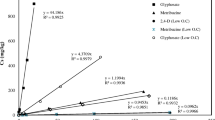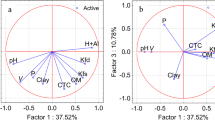Abstract
The reversible and resistant components of adsorption and desorption of munition constituents (MCs) on soils was studied to determine the environmental fate of these contaminants. The long-term desorption of MCs has applicability in formulating accurate risk assessments for operational military ranges. Batch experiments near 1:1 (w/v) soil-to-solution ratios reflecting field conditions using solutions containing mixtures of HMX, RDX, and nitroglycerine (NG) were conducted. The three soils used varied from 0.04 to 13.3 % organic matter. The experiment involved one adsorption step followed by four consecutive desorption steps. Adsorption times were 2, 5, 10, and 30 days. For each adsorption time, desorption times were carried out for 1, 12, 24 and 72 h and 30 days. The reversible/resistant component model was applied to the data. The model predicted the desorption concentrations of the MCs in the soil with root mean square errors of approximately 0.05 to 0.2 μg g soil−1. The extent of desorption hysteresis is not changed by the length of desorption time, irrespective of the initial adsorption time.








Similar content being viewed by others
Abbreviations
- MC:
-
Munition constituent
- K ow :
-
Octanol-water partition coefficient
- NG:
-
Nitroglycerine
- SOC:
-
Soil organic carbon
References
Ainsworth, C. C., Harvey, S. D., Szecsody, J. E., Simmons, M. A., Cullinan, V. I., Resch, C. T., & Mong, G. H. (1993). Relationship between the leachability characteristics of unique energetic compounds and soil properties. Final Report. Project Order No. 91PP1800. Fort Detrick: U.S. Army Biomedical Research and Development Laboratory. http://www.dtic.mil/get-tr-doc/pdf?AD=ADA267580. Accessed 20 February 2012.
Bouyoucos, G. J. (1962). Hydrometer method improved for making particle size analyses of soils. Agronomy Journal, 54(5), 464–465.
Charles, S. M., Teppen, B. J., Li, H., & Boyd, S. A. (2008). Fractional availability of smectite surfaces in soils for adsorption of nitroaromatic compounds in relation to soil and solute properties. Soil Science Society of America Journal, 72(3), 586–594.
Chemical Properties Database. (2010). Houston: Groundwater Services, Inc. http://www.gsi-net.com/UsefulTools/ChemPropDatabaseHome.asp. Accessed 25 April 2012.
Di Toro, D. M. (1985). A particle interaction-model of reversible organic-chemical sorption. Chemosphere, 14(10), 1503–1538.
Di Toro, D. M., & Horzempa, L. M. (1982). Reversible and resistant components of PCB adsorption desorption: isotherms. Environmental Science & Technology, 16(9), 594–602.
Di Toro, D. M., Mahony, J. D., Kirchgraber, P. R., O’Bryne, A. L., Pasquale, L. R., & Piccirilli, D. C. (1986). Effects of nonreversibility, particle concentration, and ionic-strength on heavy-metal sorption. Environmental Science & Technology, 20(1), 55–61.
Dontsova, K. M., Hayes, C., Pennington, J. C., & Porter, B. (2009). Sorption of high explosives to water-dispersible clay: influence of organic carbon, aluminosilicate clay, and extractable iron. Journal of Environmental Quality, 38(4), 1458–1465.
Hatzinger, P. B., Fuller, M. E., Rungmakol, D., Schuster, R. L., & Steffan, R. J. (2004). Enhancing the attenuation of explosives in surface soils at military facilities: sorption–desorption isotherms. Environmental Toxicology and Chemistry, 23(2), 306–312.
HSDB Hazardous Substances Data Bank. (2008). Bethesda: National Library of Medicine. http://toxnet.nlm.nih.gov. Accessed 20 April 2012.
Karickhoff, S. W., & Brown, D. S. (1979). Sorption of hydrophobic pollutants on natural sediments. Water Research, 13(3), 241–248.
Larson, S. L., Martin, W. A., Escalon, B. L., & Thompson, M. (2008). Dissolution, sorption, and kinetics involved in systems containing explosives, water, and soil. Environmental Science & Technology, 42(3), 786–792.
Monteil-Rivera, F., Groom, C., & Hawari, J. (2003). Sorption and degradation of octahydro-1,3,5,7-tetranitro-1,3,5,7-tetrazocine in soil. Environmental Science & Technology, 37(17), 3878–3884.
Monteil-Rivera, F., Paquet, L., Deschamps, S., Balakrishnan, V. K., Beaulieu, C., & Hawari, J. (2004). Physico-chemical measurements of CL-20 for environmental applications—comparison with RDX and HMX. Journal of Chromatography A, 1025(1), 125–132.
Myers, T. E., Brannon, J. M., Pennington, J. C., Townsend, D. M., Davis, W. M., Ochman, M. K., Hayes, C. A., & Myers, K. F. (1998). Laboratory studies of soil sorption/transformation of TNT, RDX, and HMX. Technical Report IRRP-98-8. Vicksburg: U. S. Army Engineer Waterways Experiment Station. http://libweb.wes.army.mil/uhtbin/hyperion/TR-IRRP-98-8.pdf. Accessed 20 February 2012.
Schwarzenbach, R. P., Gschwend, P. M., & Imboden, D. M. (2003). Environmental organic chemistry. Hoboken: Wiley.
Selim, H. M., Xue, S. K., & Iskandar, I. K. (1995). Transport of 2,4,6-trinitrotoluene and hexahydro-1,3,5-trinitro-1,3,5-triazine in soils. Soil Science, 160(5), 328–339.
Sheremata, T. W., Halasz, A., Paquet, L., Thiboutot, S., Ampleman, G., & Hawari, J. (2001). The fate of the cyclic nitramine explosive RDX in natural soil. Environmental Science & Technology, 35(6), 1037–1040.
Sunahara, G. I., Lotufo, G., Kuperman, R. G., & Hawari, J. (2009). Ecotoxicology of explosives. Boca Raton: CRC Press.
U.S. General Accounting Office (USGAO). (2003). Military Munitions: DOD Needs to Develop a Comprehensive Approach for Cleaning Up Contaminated Sites. Report to the Honorable John D. Dingell Ranking Minority Member, Committee on Energy and Commerce, House of Representatives. GAO-04-14. http://www.gao.gov/net.items/d04147.pdf . Accessed 20 May 2012.
Xue, S. K., Iskandar, I. K., & Selim, H. M. (1995). Adsorption-desorption of 2,4,6-trinitrotoluene and hexahydro-1,3,5-trinitro-1,3,5-triazine in soils. Soil Science, 160(5), 317–327.
Yamamoto, H., Morley, M. C., Speitel, G. E., & Clausen, J. (2004). Fate and transport of high explosives in a sandy soil: adsorption and desorption. Soil and Sediment Contamination, 13(5), 459–477.
Zhang, D. M., Zhu, D. Q., & Chen, W. (2009). Sorption of nitroaromatics to soils: comparison of the importance of soil organic matter versus clay. Environmental Toxicology and Chemistry, 28(7), 1447–1454.
Acknowledgments
This study was supported by the SERDP (Strategic Environmental Research and Development Program Project ER-1688). The authors thank the U.S. Army Edgewood Chemical Biological Center (ECBC) at the Aberdeen Proving Ground for their support and collaboration.
Conflict of Interest
The authors declare that they have no competing interests.
Author information
Authors and Affiliations
Corresponding author
Additional information
Rosalina Gonzalez and Kyle Michelson provided equal effort in conducting the experiments.
Rights and permissions
About this article
Cite this article
Gonzalez, R., Michelson, K., Di Toro, D.M. et al. Modeling the Reversible and Resistant Components of Munition Constituent Adsorption and Desorption on Soils. Water Air Soil Pollut 226, 219 (2015). https://doi.org/10.1007/s11270-015-2486-3
Received:
Accepted:
Published:
DOI: https://doi.org/10.1007/s11270-015-2486-3




